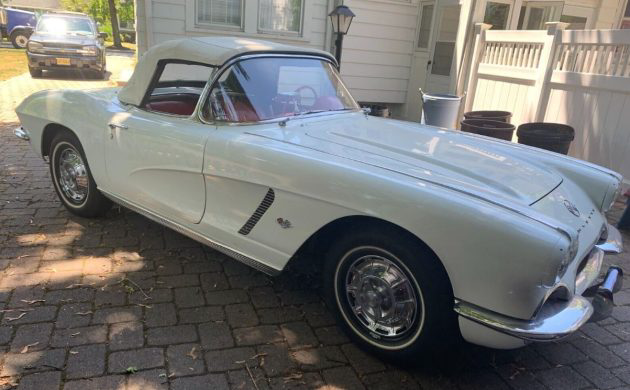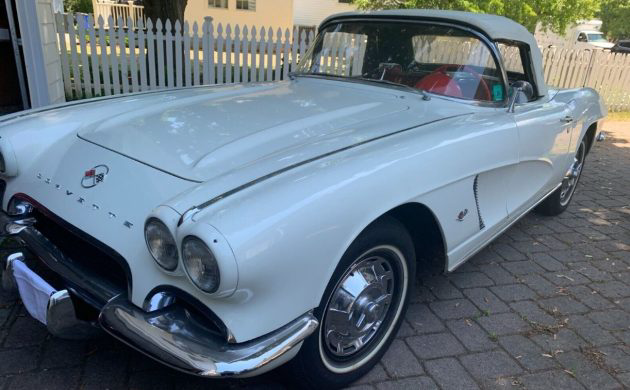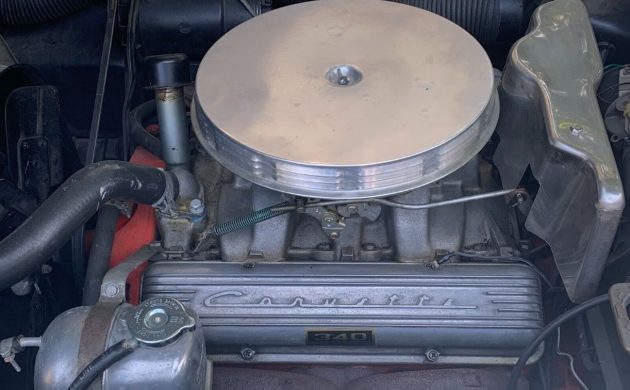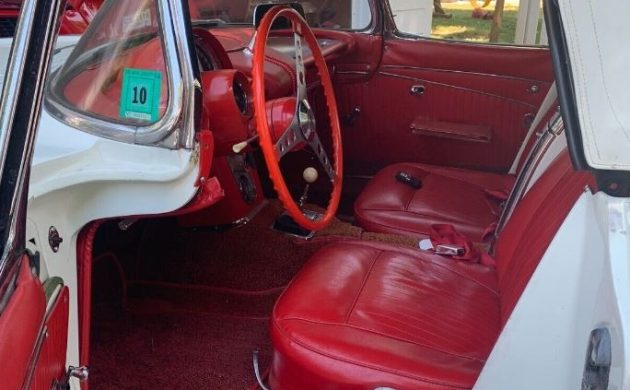The 1962 Corvette was a significant car in the badge’s long and illustrious history. Not only was it the final year of C1 production, but it was also the last time that any generation of Corvette would be available exclusively as a Convertible during its production run. Our feature car is a tidy classic featuring a desirable drivetrain combination. It should be civilized under most circumstances but offer exhilarating performance if provoked. It has attracted plenty of interest since hitting the market, and with the auction reserve met, its next journey should be to a new home.
The seller is only this Corvette’s second owner, having become its custodian approximately five years ago. The car’s panels wear Ermine White paint with a matching soft-top. They don’t mention previous repairs or restoration, but the exterior presentation is impressive if it is a genuine survivor. The paint holds a nice shine, with any flaws in the paint or fiberglass too insignificant to show in the supplied images. The top has a slightly dirty appearance, but with no evidence of rips or tears, deep cleaning might have a positive impact without spending a fortune. The seller states the frame is rock-solid, and the trim is in impressive condition for its age. The glass is clear, and the original wheels and hubcaps are complimented by the almost new Vercelli whitewall tires.
The biggest news for 1962 hid under the Corvette’s hood. Chevrolet enlarged the V8, increasing its capacity from 283 to 327ci. Over 66% of buyers selected one of the three optional versions of that motor, with 30% selecting the RPO 396 engine, producing 340hp and 344 ft/lbs of torque. Its popularity is understandable, because it added only $107.60 to the car’s sticker price, but delivered 27% more power. The first owner teamed that motor with a four-speed manual transmission, allowing this ‘Vette to storm the ¼-mile in 14.4 seconds. The seller purchased the car five years ago, but since it has only clocked 600 miles while in their care, they haven’t exactly tried to wear it out. The battery was relocated to the trunk, but that is the only apparent mechanical change. They don’t indicate how it runs or drives, although the visual indications are positive. However, it is worth contacting the seller when dealing with any classic to confirm that all is well.
If this Corvette has a genuine weakness, that honor may fall to its interior. It is undeniably serviceable, but the seller admits it would benefit from a refresh. There are no visible gaping holes or other problems. It simply looks tired and ready for at least a partial retrim and new carpet. Unsurprisingly, the clock and original Wonderbar radio stopped working. The seller sourced and fitted reproductions for both but includes the original units if the winning bidder chooses to send them for restoration. Purists will probably follow that path, which is understandable.
The seller listed this 1962 Chevrolet Corvette here on eBay in Pompton Plains, New Jersey. Thirty bids have pushed the price beyond the reserve to $45,000, which means that barring unforeseen circumstances, it is less than a week away from heading to a new home and its third owner. Purists will probably dislike the minor changes made by the seller, but the keyword there is “minor.” None are significant, and all are reversible if the buyer prefers originality. Would you reverse them if you became the winning bidder, or would you leave this classic as-is?






Why move the battery from engine compartment to the trunk? No good.
Agreed, but easy enough to remedy.
Moving the battery provides more weight over the rear end for better traction. This has been common practice for decades.
Not only that the heat from the engine compartment will hasten the life of the battery.
There isn’t much to gain by moving the battery in a street driven car unless there is no room under the hood or it’s crazy hot up front.
I’m sure it’s just a typo, but just to clarify, ’62 Vettes weren’t available with a 396 because that motor was just some GM engineers dream in ’62. (The 327/340 was a nice little screamer though.) Neat little car nonetheless,
I believe RPO396 was the order number for the 340 hp engine option/
I stand corrected. 396 was indeed the RPO for the 340 horse motor. My mistake.
Yeah, a 396 big block in ‘62 would be as rare as a fresh Chick-fil-A sandwich on a Sunday afternoon! But loved it in the ‘65’s.
This is one of 4,414 produced with an RPO396 327/340hp V8 engine paired with an RPO685 4-speed manual transmission. It has spinner hubcaps and whitewall tires.
Beautiful car, and I like the 61-62 Vette especially because of the C2-type tail. Were there aftermarket hardtops for these cars? I seem to recall seeing a few..
I don’t know about after market hardtops, but probably 90 percent of them came from the factory with one, so I’m sure that finding one wouldn’t be all that difficult.
@ Charles Jenkins,,,,,,,,,, At one time this particular Corvette had a factory hard top because you can see the 2 ferrules for the hold downs on the lid that the tops sit on.
Agreed Terry. Greaser look in front. A little hard rock in the back.
My uncle had a ’62 Vette … being only eleven years old I don’t know which engine it had … my dad had a ’60TBird with a 430 … they raced on a stretch of Hwy 40 in Louisiana … my uncle’s engine blew (meaning my dad won) and the local dealer replaced his engine under warranty … back then, as much as now, it was “Ford vs Chevy” …
That 340 put out the greatest music this side of….anyone. And it was as fast as it sounded.
My father had one in the early 90’s. 300hp 327 4 speed. Black with red interior. I was teenager and it was hard to drive. No hydraulic clutch and at 6’3″‘ that steering wheel was in the way. Still loved the car. This was in Ottawa Canada. A guy flew in from Arizona to buy it and oversee it being loaded up to be shipped to him.
Very nice example. I always loved a 1962 Corvette. If I wasn’t broke, I would definitely bid on that car. I love the white exterior and red interior.
Just an FYI, but those old analog clocks are fun and easy to repair. They run by a spring loaded set of points (just like ignition points) the mechanism gets dirty and / or the points get pitted and you can just polish up the points, very lightly oil the clock mechanism, and you’re good to go. I would wager that the clock in my ‘62 Impala SS was identical, at least internally.
Bidders either need to unleash some more of their musty money. I highly doubt the seller will let it go that cheap. This car appears to be unmolested and in great condition.
Fifty or so years ago, I was studying automotive mechanics at a CC in Gresham Or, the department chair had a 62 for a driver. Then he got the idea of starting a car club and the Vette was turned into a dragster. I don’t know what happened after that.